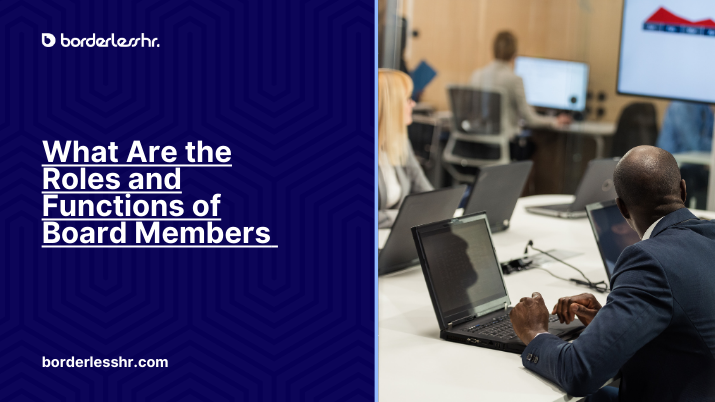The idea of having board member roles and responsibilities is to ensure that there are several people occupying different roles involved in decision making.
Each board member has their own role and expertise at the executive level to help a company succeed. Board members play a key role in the daily and long-term operations of an organization.
They serve as a protective entity for the interests of a company’s shareholders, and they meet regularly to discuss ways to increase returns and overall profits for the company. They are also actively involved in the decisions made by the organization which means their actions has a direct impact on the organization. If you want to understand what board members do, then you need to know their functions. In this article, we’ll talk about the various roles and responsibilities of board members.
Who Are Board Members and How Are They Appointed?
Board members or a board of directors are a group of people selected by a company’s shareholders to represent their interests. The board acts as a governing body for a company or corporation.
Their main aim is to protect the assets of the shareholders by making sure the organization’s management acts on their behalf and that they get a good return on their investment (ROI) in the company. They do this by meeting regularly to create policies for overall company oversight and management.
Having a board of directors is very important. They’re critical to success of a company and are responsible for the downfall of growth of the company. They have a collective responsibility to govern the organization.
What this means is that the board member roles and responsibilities should be clearly defined. Each board member needs to fully understand the expectations of their position. They’ll be held accountable when they go off track. So if they don’t know what the job entails, it’s not possible for them to perform effectively or live up to the expectations.
What are the board member roles and responsibilities?
Hiring and evaluating the CEO
The board of directors holds the authority to appoint, replace, and evaluate the CEO of a company, as well as establish criteria for measuring the CEO’s performance. When considering a new CEO, board members assess the organization’s current state and objectives to identify key requirements. This process guides the creation of the job description and the search for suitable candidates, often drawing from industry peers. For instance, if the company aims to enhance its digital footprint, the board may prioritize candidates with expertise in technology or digital marketing.
Following the CEO selection, the board supervises their duties, team management, and performance benchmarks. They outline strategic objectives for the CEO’s initial tenure and evaluate progress accordingly. Failure to meet set expectations may prompt the board to seek a replacement CEO to better align with the company’s objectives.
Allocation and protection of company resources
Deciding how to distribute financial assets, personnel, and equipment effectively within a business is what resource allocation entails. Regardless of their role, whether as executives or shareholders, every member of the board must decide which departments or teams will receive more or fewer resources based on the organization’s strategic objectives and mission. For instance, if a company aims to boost revenue through social media engagement, the board might opt for increased investment in advertising and advanced algorithmic tools to enhance customer targeting.
In addition to resource allocation, the board may also establish security protocols to safeguard their data, personnel, and intellectual property. Given their legal obligation to maintain transparency in asset management and protection, board members may communicate pertinent risks and responsibilities to employees, such as the necessity of regular password updates.
Overseeing the finances of the company
A board oversees the company’s budget and sales objectives, convening regularly to analyze present financial data and forecast future trends. Firms may implement automated systems or manual checks to ensure adherence to financial protocols by all team members. Additionally, some companies establish internal audit teams or enlist external auditors to scrutinize financial activities and reports, ensuring regulatory compliance.
Making financial decisions
In addition to overseeing finances in general, the board is responsible for some of the most significant financial determinations within a company. These decisions encompass potential mergers, acquisitions, divestments from specific assets, or transitions to new office premises. A diverse board comprising individuals with varied perspectives can greatly enhance the company’s advantage, as it ensures a thorough deliberation and consensus on crucial financial matters.
Managing each other
The board members have a collective responsibility to oversee one another. When they select a CEO, the board retains the authority to recruit or dismiss board members according to the demands of the business. For instance, if the board identifies a need for specialized assistance in a particular domain, it may explore candidates from within the organization’s executive ranks or external investors possessing relevant expertise. The board possesses the prerogative to draft job descriptions, supervise performance, and assess potential additions to its ranks. Periodically, the board may engage in self-assessment exercises to identify areas for improvement and adaptation.
Creating a vision for the company
Members of the board have the authority to establish the core values of a company as well as its future strategies. This encompasses setting short- and long-term objectives, devising strategic plans, and shaping the work environment. For instance, a company specializing in educational technology may aspire to deploy its course platform in 50% of schools nationwide.
Additionally, team members may propose various objectives aligned with their respective visions and convene meetings to deliberate on which objectives to pursue. Subsequently, the leadership team, comprising the CFO and CEO, can disseminate the vision to their teams. The board may convene monthly meetings to assess this vision, ensuring that employees comprehend and endorse the plans while equipping them with the necessary resources for implementation.
Setting strategies
Another fundamental role of a board of directors is strategic planning. After defining its mission and objectives, the board determines the pathways to realizing these goals. Take, for instance, a technology firm faced with the choice between outsourcing and expanding internal teams. Evaluating the merits and drawbacks of each option, the board deliberates on the most effective approach for advancing the company’s objectives.
The Characteristics of Effective Board Members
A proficient board member embodies specific traits pivotal for successfully steering and overseeing an organization. These attributes encompass:
- Competence and expertise: Board members offer a range of skills, knowledge, and industry expertise, enabling them to provide valuable insights and make well-informed decisions.
- Collaboration and communication: Effective boards actively engage in discussions, attentively consider diverse viewpoints, and foster constructive dialogue to arrive at informed decisions.
- Accountability: Board members demonstrate integrity, uphold ethical standards, and ensure transparency in governance practices.
Independence: A robust board comprises independent directors devoid of personal or financial affiliations that could compromise their commitment to the organization’s best interests.
By embodying these characteristics, an adept board of directors can furnish strong leadership, strategic direction, and vigilant oversight.







